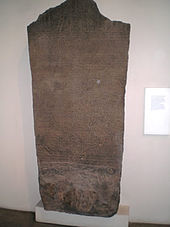Amanirenas
Amanirenas was a reigning Nubian queen who lived around 20 BC. Ruled.
It is known from four inscriptions. In two of them it is referred to as kdke ( kandake ). Both inscriptions come from King Teriteqas , who is also mentioned in them. So she was certainly his wife. In two other inscriptions, on a bronze naos from Kawa and on a stele from Hamadab , she is referred to as the qore - king. It can be assumed that after her husband's death, she ascended the throne and reigned as queen.
The stele from Hamadab is one of the longest known texts in Meroitic script and also names Prince Akinidad . Although the text on the stele (and a second heavily weathered one) is difficult to understand, it has been assumed that a war against Rome is being reported here (a word poor appears that can be translated as Rome ). Indeed, a war between the Roman Empire and Nubia under Emperor Augustus is for the year 25-24 BC. In which the Romans devastated some cities in Lower Nubia, but then had to give up and were defeated by the Nubians. If this interpretation of the stele is correct, it gives a clue for the dating of Amanirenas.
Since Akinidad is also documented under Amanischacheto , it can be assumed that this was the successor of the Amanirenas.
The burial place of Amanirenas is believed to be in the pyramid Beg N21 in Meroe .
It is probably identical with the one-eyed Kandake, which Strabo calls .
See also
literature
- László Török in Tormod Eide u. a .: Fontes historiae nubiorum: textual sources for the history of the middle Nile region between the eighth century BC and the sixth century AD. Vol. 2. From the mid fifth to the first century BC (= Fontes historiae Nubiorum. Volume 2). University of Bergen, Bergen 1996, ISBN 82-91626-01-4 , pp. 718-723.
- Steffen Wenig : Amanirenas. In: Wolfgang Helck (Hrsg.): Lexikon der Ägyptologie (LÄ). Volume I, Harrassowitz, Wiesbaden 1975, ISBN 3-447-01670-1 , Sp. 170.
Individual evidence
- ↑ a b Little: Lexicon of Egyptology. Volume I, Wiesbaden 1975, column 170.
- ^ Strabo, Geographica 17, 54.
| personal data | |
|---|---|
| SURNAME | Amanirenas |
| BRIEF DESCRIPTION | nubian queen |
| DATE OF BIRTH | before 20 BC Chr. |
| DATE OF DEATH | 1st century BC BC or 1st century |

